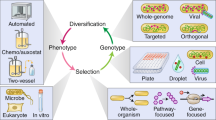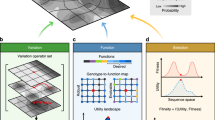Abstract
Computational scientists have developed algorithms inspired by natural evolution for at least 50 years. These algorithms solve optimization and design problems by building solutions that are 'more fit' relative to desired properties. However, the basic assumptions of this approach are outdated. We propose a research programme to develop a new field: computational evolution. This approach will produce algorithms that are based on current understanding of molecular and evolutionary biology and could solve previously unimaginable or intractable computational and biological problems.
This is a preview of subscription content, access via your institution
Access options
Subscribe to this journal
Receive 12 print issues and online access
$189.00 per year
only $15.75 per issue
Buy this article
- Purchase on Springer Link
- Instant access to full article PDF
Prices may be subject to local taxes which are calculated during checkout

Similar content being viewed by others
References
Foster, J. A. Evolutionary computation. Nature Rev. Genet. 2, 428–436 (2001).
Fogel, D. (ed.) Evolutionary Computation: the Fossil Record (IEEE Press, New York, 1998).
Langdon, W. B. & Gustafson, S. Genetic programming and evolvable machines: five years of reviews. Genet. Programming Evolvable Machines 6, 221–228 (2005).
Cotta, C. & Merelo, J. J. The complex network of evolutionary computation authors: an initial study. Physics Abstracts [online], (2006).
Fogel, L. J., Owens, A. J. & Walsh, M. J. Artificial Intelligence through Simulated Evolution (Wiley, New York, 1966).
Holland, J. H. Adaptation in Natural and Artificial Systems 2nd edn (MIT Press, Massachusetts, 1993).
Rechenberg, I. Evolutionsstrategie 2nd edn (Frommann, Stuttgart, Germany, 1993) (in German).
Koza, J. Genetic Programming (MIT Press, Massachusetts, 1992).
Cage, P. G., Kroo, I. M. & Braun, R. D. Interplanetary trajectory optimization using a genetic algorithm. J. Astronautical Sci. 43, 59–75 (1995).
Stoica, A., Klimeck, G., Salazar-Lazaro, C., Keymeulen, D. & Thakoor, A. Evolutionary design of electronic devices and circuits. Proc. 1999 Congress Evol. Computation 1271–1278 (IEEE Press, New York, 1999).
Barnum, H., Bernstein, H. J. & Spector, L. Quantum circuits for OR and AND of ORs. J. Phys. A 33, 8047–8057 (2000).
Koza, J. et al. Genetic Programming IV: Routine Human–Competitive Machine Intelligence (Kluwer Academic, Massachusetts, 2003).
Koza, J., Keane, M., Yu, J., Bennett, F. H. III & Mydlowec, W. Automatic creation of human–competative programs and controllers by means of genetic programming. Genet. Programming Evolvable Machines 1, 121–164 (2000).
Vaario, J. From evolutionary computation to computational evolution. Informatica 18, 417–434 (1994).
Yeh, E. -C., Venkata, S. S. & Sumic, Z. Improved distribution system planning using computational evolution. Proc. Power Industry Comp. App. Conf. 530–536 (IEEE Press, Pittsburgh, 1995).
Judson, R. Computational evolution of a model polymer that folds to a specified target conformation. Proc. Pacific Symp. Biocomputing 423–437 (World Scientific, Singapore, 1996).
Morange, M. Gene function. C.R. Acad. Sci. Paris 323, 1147–1153 (2000).
Ramsden, J. J. Bioinformatics: An Introduction (Kluwer Academic, Dordrecht, 2004).
Kapranov, P., Cawley, S. E. & Drenkow, J. Large-scale transcriptional activity in chromosomes 21 and 22. Science 296, 916–919 (2002).
Gruau, F. Genetic synthesis of modular neural networks. Proc. 5th Int. Conf. Genet. Algorithms 318–325 (Morgan Kaufmann, San Francisco, 1993).
O'Neill, M. & Ryan, C. Grammatical Evolution: Evolutionary Automatic Programming in an Arbitrary Language (Kluwer Academic, Dordrecht, 2003).
Koza, J. R., Andre, D., Bennett, F. H. & Keane, M. Genetic Programming 3: Darwinian Invention and Problem Solving (Morgan Kaufman, San Francisco, 1999).
Keller, R. E. & Banzhaf, W. The evolution of genetic code in genetic programming Proc. Genet. Evol. Computation Conf. 1077–1082 (Morgan Kaufmann, San Francisco, 1999).
Goldberg, D. E. The Design of Innovation: Lessons from and for Competent Genetic Algorithms (Kluwer Academic, Dordrecht, 2002).
De Jong, K. Evolutionary Computation: a Unified Approach (MIT Press, Cambridge, Massachusetts, 2006).
Ramsden, J. J. Paracelsus: the measurable and the unmeasurable. Psyche Problems Persp. 4, 52–88 (2004).
Ramsden, J. J. Computational aspects of consciousness. Psyche Problems Persp. 1, 93–100 (2001).
Képès, F. Periodic transcriptional organization of the E. coli genome. J. Mol. Biol. 340, 957–964 (2004).
Coen, E. The Art of Genes (Oxford Univ. Press, Oxford, 1999).
Conrad, M. in A Half-Century Survey on the Universal Turing Machine 285–307 (Oxford Univ. Press, New York, 1988).
Miller, J. F. & Downing, K. L. Evolution in materio: Looking beyond the silicon box. Proc. NASA / DoD Conf. Evolvable Hardware 167–176 (IEEE Computer Society, Virginia, 2002).
Harding, S. & Miller, J. F. Evolution in materio: A tone discriminator in liquid crystal. Proc. Congress Evol. Comp. 2004 2, 1800–1807 (2004).
Dittrich, P., Ziegler, J. & Banzhaf, W. Artificial chemistries — a review. Artificial Life 7, 225–275 (2001).
Sims, K. Evolving virtual creatures. Proc. 21st Annu. Conf. Comp. Graphics Interactive Technol. 15–22 (ACM Press, New York, 1994).
Pollack, J. B., Lipson H., Hornby, G. & Funes, P. Three generations of automatically designed robots. Artificial Life 7, 215–223 (2001).
Rieffel, J. & Pollack, J. The emergence of ontogenic scaffolding in a stochastic development environment. Lecture Notes Comp. Sci. 3102, 804–815 (Springer, Berlin, 2004).
Ray, T. An approach to the synthesis of life. Proc. Artificial Life II 371–408 (Addison-Wesley, Boston, 1991).
Adami, C. An Introduction to Artificial Life (Springer, Berlin, 1999).
Lones, M. A. & Tyrrell, A. Biomimetic representation with enzyme genetic programming. Genet. Programming Evolvable Machines 3, 193–217 (2002).
Érdi, P. & Barna, G. Self-organizing mechanism for the formation of ordered neural mappings. Biol. Cybern. 51, 93–101 (1984).
Luthi, P. O., Preiss, A., Chopard, B. & Ramsden, J. J. A cellular automaton model for neurogenesis in drosophila. Physica D 118, 151–160 (1998).
McKinney, M. Heterochrony: Beyond words. Paleobiology 25, 149–153 (1999).
Ramsden, J. J. in Creatine Kinase and Brain Energy Metabolism (eds Kekelidze, T. & Holtzmann, D.) 55–58 (IOS Press, Amsterdam, 2003).
Eggenberger-Hotz, P. Genome-physics interaction as a new concept to reduce the number of genetic parameters in artificial evolution. Proc. Congress Evolutionary Computation (IEEE Press, New York, 2003).
Kuo, P. D., Leier, A. & Banzhaf, W. Evolving dynamics in an artificial regulatory network model. Lecture Notes Comp. Sci. 3242, 571–580 (Springer, Berlin, 2004).
Gould, S. J. & Vrba, E. Exaptation: a missing term in the science of form. Paleobiology 8, 4–15 (1982).
Berenbrink, M., Koldkjaer, P., Kepp, O. & Cossins, A. R. Evolution of oxygen secretion in fishes and the emergence of a complex physiological system. Science 307, 1752–1757 (2005).
Szathmáry, E. & Maynard-Smith, J. The major evolutionary transitions. Nature 374, 227–232 (1995).
Hartwell, L. H., Hopfield, J. J., Leibler, S. & Murray, A. W. From molecular to modular cell biology. Nature 402, C47–C52 (1999).
Simon, H. A. How complex are complex systems? Proc. 1976 Biennial Meeting Philos. Sci. Assoc. 2, 507–522 (Edwards Bros, Ann Arbor, 1977).
Ashby, W. R. Requisite variety and its implications for the control of complex systems. Cybernetica 1, 84–99 (1958).
Muotri, A. R. et al. Somatic mosaicism in neuronal precursor cells mediated by L1 retrotransposition. Nature 435, 903–910 (2005).
Meysenburg, M. M., Hoelting, D., McElvain, D. & Foster, J. A. How random generator quality impacts genetic algorithm performance. Proc. Genet. Evolutionary Computation Conf. 480–483 (Morgan Kaufmann, San Francisco, 2002).
Altenberg, L. in Advances in Genetic Programming (ed. Kinnear, K. E.) 47–74 (MIT Press, Cambridge, Massachusetts, 1994).
Radman, M., Matic, I. & Taddei, F. Evolution of evolvability. Ann. NY Acad. Sci. 870, 146–155 (1999).
Earl, D. & Deem, M. Evolvability is a selectable trait. Proc. Natl Acad. Sci. USA 101, 11531–11536 (2004).
Dawkins, R. in Artificial Life (ed. Langton, C.) 201–220 (Addison Wesley, Boston, 1989).
Wagner, G. P. & Altenberg, L. Complex adaptations and the evolution of evolvability. Evolution 50, 967–976 (1996).
Kirschner, M. W. & Gerhard, J. C. The Plausibility of Life (Yale Univ. Press, New Haven, 2005).
Shapiro, J. A. A 21st century view of evolution: genome system architecture, repetitive DNA, and natural genetic engineering. Gene 345, 91–100 (2005).
Ramsden, J. J. & Vohradský, J. Zipf-like behavior in procaryotic protein expression. Phys. Rev. E 58, 7777–7780 (1998).
Mayr, E. What is a species and what is not? Philos. Sci. 63, 262–277 (1996).
Avise, J. Phylogeography: the History and Formation of Species (Harvard Univ. Press, Massachusetts, 2000).
Arber, W. in Frontiers in Biology (eds Chou, C.-H. & Shao, K.-T.) 19–24 (Academia Sinica, Taipei, 1998).
Margulis, L. & Sagan, D. Acquiring Genomes: a Theory of the Origins of Species (Basic Books, New York, 2002).
Deb, K. & Goldberg, D. An investigation of niche and species formation in genetic function optimization. Proc. 3rd Int. Conf. Genet. Algorithms 42–50 (Morgan Kaufmann, San Francisco, 1989).
Fonseca, C. M. & Fleming, P. J. Multiobjective genetic algorithms made easy: selection, sharing, and mating restriction. Proc. 1st Int. Conf. Genet. Algorithms Engineering Systems Innovations Appl. 45–52 (IEEE Press, New York, 1995).
International Business Machines. Autonomic computing. IBM Research | Autonomic Computing [online], (2006).
Ridley, M. Evolution (Blackwell Science, Oxford, 1996).
Reil, T. Dynamics of gene expression in an artificial genome-implications for biological and artificial ontogeny. Adv. Artificial Life — Proc. 5th European Conf. Artificial Life 1674, 457–466 (1999).
Watson, J., Geard, N. & Wiles, J. Towards more biological mutation operators in gene regulation studies. BioSystems 76, 239–248 (2004).
Volkert, L. G. & M. Conrad The role of weak interactions in biological systems: the dual dynamics model. J. Theo. Bio. 193, 287–306 (1998).
Bongard, J. Evolving modular genetic regulatory networks. Proc. 2002 Congress Evolutionary Computation 2, 1872–1877 (IEEE Press, New York, 2002).
Eggenberger, P. Evolving morphologies of simulated 3D organisms based on differential gene expression. Proc. 4th European Conf. Artificial Life 205–213 (MIT Press, Cambridge, Massachusetts, 1997).
Volkert, L. G. Enhancing evolvability with mutation buffering mediated through multiple weak interactions. Biosystems 69, 127–142 (2003).
Acknowledgements
We thank the people at Genopole Recherche, Évry, France, for generously sponsoring the meeting that initiated this paper. We also thank the anonymous referees for helpful suggestions.
Author information
Authors and Affiliations
Corresponding authors
Ethics declarations
Competing interests
The authors declare no competing financial interests.
Related links
Rights and permissions
About this article
Cite this article
Banzhaf, W., Beslon, G., Christensen, S. et al. From artificial evolution to computational evolution: a research agenda. Nat Rev Genet 7, 729–735 (2006). https://doi.org/10.1038/nrg1921
Published:
Issue Date:
DOI: https://doi.org/10.1038/nrg1921
This article is cited by
-
A biological perspective on evolutionary computation
Nature Machine Intelligence (2021)
-
Evolution of complex adaptations in molecular systems
Nature Ecology & Evolution (2017)
-
Evolution-in-materio: solving computational problems using carbon nanotube–polymer composites
Soft Computing (2016)
-
From evolutionary computation to the evolution of things
Nature (2015)



